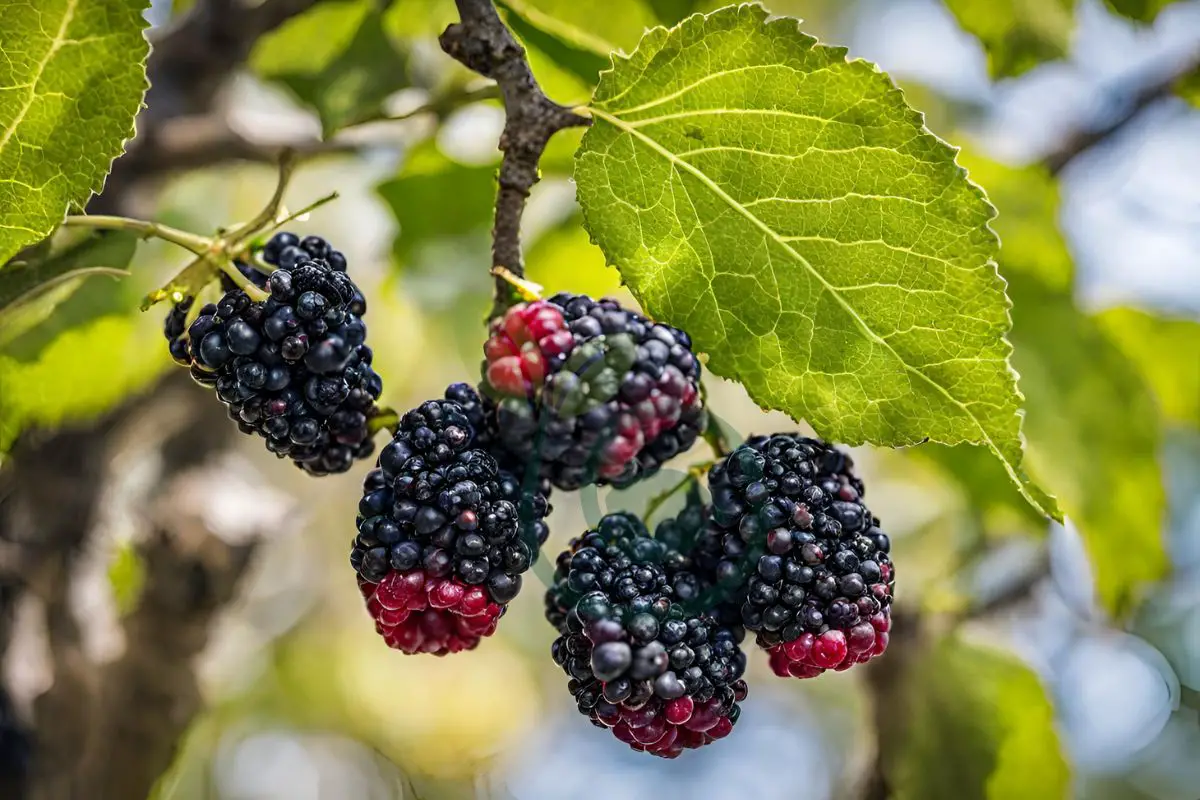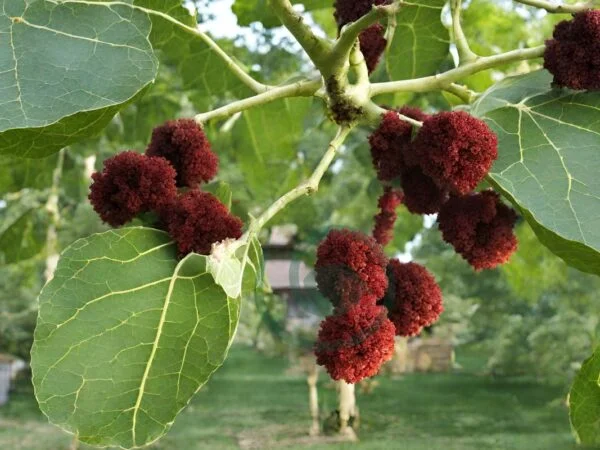Did you know that mulberries, a berry, are not only enjoyed by birds and wildlife but can also be a delectable treat for humans? These juicy berries grow abundantly on mulberry trees, tempting passersby with their sweet and tangy flavor. While some may hesitate to indulge in these fruits due to uncertainty about their edibility, rest assured that mulberries are safe for human consumption. In fact, they are packed with nutrients like Vitamin C and antioxidants, making them a healthy snack option straight from nature's bounty.
So, if you've ever wondered whether you can eat the berries off a mulberry tree, the answer is a resounding yes! Get ready to discover the joy of plucking ripe mulberries from wild mulberry trees and savoring their natural goodness right from the source.
Key Takeaways
- Identify Mulberries: Look for the distinctive characteristics of mulberry trees to correctly identify them before consuming the berries.
- Locate Mulberry Trees: Scout areas with ample sunlight and well-drained soil to find mulberry trees, often found in parks, gardens, or along roadsides.
- Forage Safely: Ensure the berries are ripe and free from contamination before consuming them to avoid any potential health risks.
- Enjoy Health Benefits: Incorporate mulberries into your diet to benefit from their high levels of vitamins, antioxidants, and other nutrients.
- Experiment in the Kitchen: Explore various culinary uses of mulberries such as jams, pies, or smoothies to enjoy their unique flavor profile.
- Manage Invasiveness: Be cautious when planting mulberry trees as they can spread rapidly and require proper management to prevent overgrowth.
Identifying Mulberries
Morus Genus
Mulberry trees fall under the Morus genus, which is part of the Moraceae family. This genus encompasses various species of mulberries with distinct characteristics and features. The Morus genus includes a wide range of mulberry trees that produce different types of berries.
Some common species within the Morus genus are known for their unique traits and variations in fruit color. For instance, red, black, and white mulberries are prevalent among the different species. Each type offers its own flavor profile and nutritional benefits, making them popular choices for consumption.
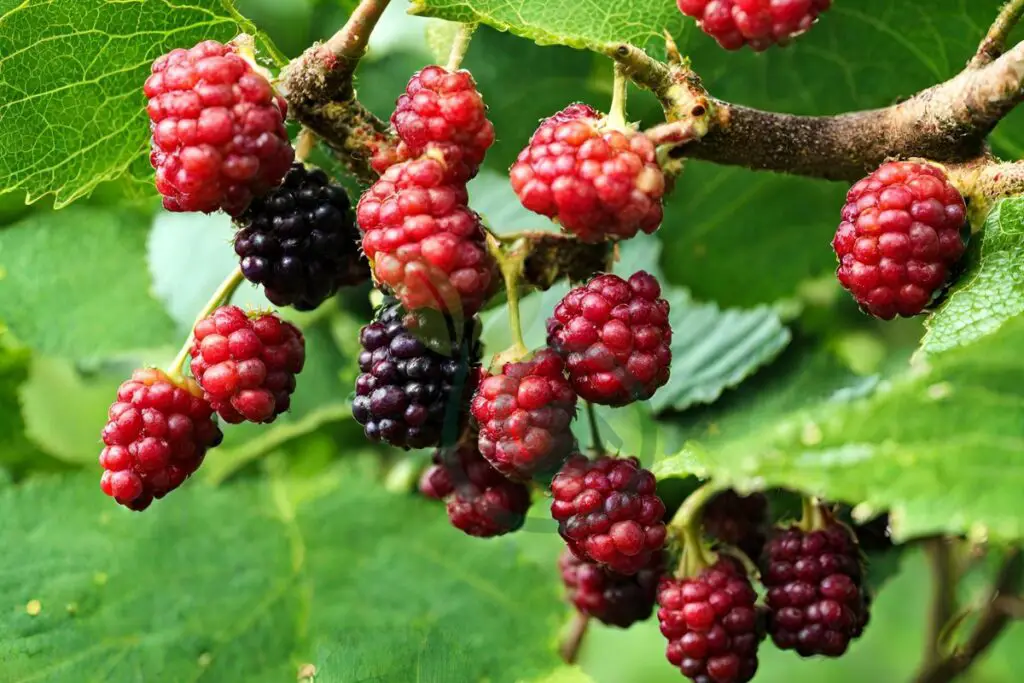
Characteristics
One distinguishing feature of mulberry trees is their deciduous leaves that shed annually during specific seasons. These leaves play a vital role in photosynthesis and contribute to the overall health and growth of the tree. Mulberry fruits exhibit a diverse color palette ranging from vibrant reds to deep blacks and even shades of white.
In terms of size, mulberry trees can reach heights of up to 30 feet as they mature. Their tall stature provides ample space for these fruit-bearing trees to thrive in fertile soil and yield abundant harvests throughout their lifespan.
Locating Mulberry Trees
Wild Varieties
Wild mulberries like Morus rubra, Morus alba, and Morus nigra are commonly found in forests. These trees grow naturally in various regions worldwide. When searching for wild mulberry trees, exploring forests and natural habitats with suitable soil is crucial. The different varieties offer a range of flavors and colors that add diversity to the landscape.
Exploring these areas can lead to discovering an abundance of ripe mulberries ready for harvesting. Each variety may have subtle differences in taste, making the experience unique with every tree encountered. Foraging for wild mulberries not only provides a rewarding harvest but also connects individuals with nature by engaging in this hands-on activity.
Optimal Harvesting
To enjoy fresh mulberries from a tree, it's essential to know when they are fully ripe and ready for picking. Ripe mulberries effortlessly detach from the tree when gently plucked, signaling their readiness for consumption. Morning hours are ideal for harvesting as the cool temperatures help preserve the fruit's quality by reducing damage risks.
Harvesting practices play a significant role in maintaining the integrity of freshly picked mulberries. By handling them carefully during collection, minimal bruising occurs, ensuring that each berry remains intact until consumed or processed further. This attention to detail guarantees a delightful eating experience while savoring the fruits' natural sweetness.
Tree Size Management
Managing mulberry trees' size through pruning is vital for promoting optimal fruit production and overall health. Regular pruning sessions aid in controlling tree growth while enhancing air circulation within its canopy structure. Properly pruned trees not only bear more fruit but also become visually appealing additions to any garden or landscape setting.
Pruning activities contribute to easier maintenance routines by keeping mulberry trees at manageable sizes suited for efficient harvesting practices without compromising productivity levels. Well-maintained trees exhibit robust growth patterns that result in bountiful harvests year after year.
Edibility and Safety
Consuming Mulberries
Mulberries are versatile fruits that can be enjoyed in various ways. You can eat them fresh right off the tree, or incorporate them into different recipes. For a quick and healthy option, add mulberries to your morning smoothie for a burst of sweetness and nutrition.
Dried mulberries also make a convenient snack that is rich in nutrients. They can be consumed on their own as a tasty treat or mixed into trail mixes for an energy-boosting snack during outdoor activities. Moreover, if you have a sweet tooth, consider using mulberries in desserts like pies or jams to elevate the flavors with their unique taste.
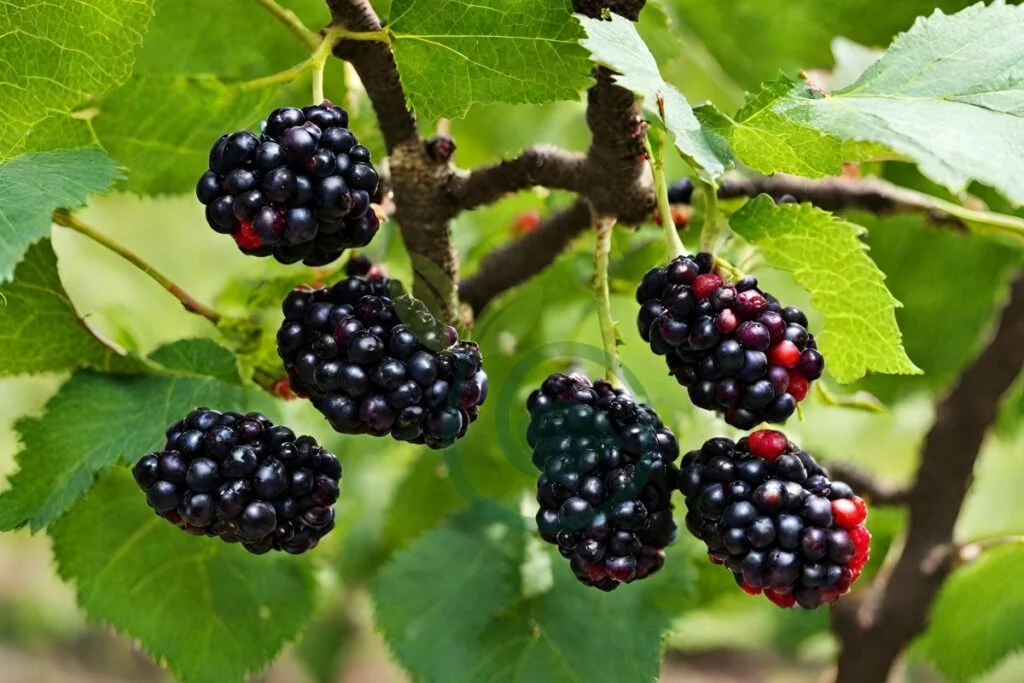
Nutritional Benefits
The nutritional profile of mulberries makes them not only delicious but also beneficial for your health. These berries are packed with antioxidants, which help protect your cells from damage caused by free radicals. They are excellent sources of vitamin C, iron, and dietary fiber essential for maintaining overall well-being.
Consuming mulberries regularly may contribute to strengthening your immune system due to their high vitamin C content. The presence of iron in these berries supports healthy blood circulation while the dietary fiber aids digestion and promotes gut health over time.
Safety Precautions
While mulberries are generally safe for consumption by most people, it's crucial to take some precautions before indulging in these juicy fruits. Some individuals might have allergies or sensitivities to certain foods like mulberries; therefore, it's advisable to start with small quantities if you're trying them for the first time.
To ensure safety when eating freshly picked mulberries from trees you've located earlier on: wash them thoroughly before consuming to remove any dirt or contaminants they might have collected outdoors. If you have known food allergies or underlying medical conditions such as pollen allergies (as some people allergic to birch pollen may react), consulting a healthcare professional before adding this fruit to your diet is recommended.
Foraging for Mulberries
Benefits of Foraging
Foraging for mulberries offers a chance to immerse yourself in nature, enjoying the great outdoors while reaping the benefits of fresh, chemical-free fruits. It's an excellent way to gather organic produce inexpensively and explore your environment simultaneously. Imagine strolling through a park or forest, plucking ripe mulberries straight from the tree.
Engaging in foraging practices not only connects you with nature but also provides access to nutritious food without any harmful chemicals. Picture yourself harvesting a handful of juicy mulberries, knowing they are free from pesticides and full of natural goodness. It can be an economical way to enjoy delicious fruits while venturing into the wilderness.
Sustainable Practices
When gathering mulberries, remember that sustainable foraging involves taking only what you need and leaving ample fruit for wildlife and fellow foragers. By adopting organic farming techniques and avoiding pesticides when cultivating these berries, you contribute to environmental sustainability. Consider planting native mulberry species in your area; this simple act can enhance biodiversity and support local ecosystems by providing habitats and food sources.
Practicing sustainable methods ensures that future generations can continue benefiting from the abundance of mulberry trees without depleting natural resources unnecessarily. By recognizing the importance of maintaining ecological balance through responsible harvesting practices, we preserve our environment's health.
Distinguishing Lookalikes
Differentiating between true mulberries and similar-looking berries like blackberries or raspberries is essential when foraging. While blackberries grow on thorny bushes, mulberries hang delicately from trees—making them easier to reach without getting pricked by thorns! The distinctive shape and color of mulberry fruits set them apart from their lookalikes.
In addition to observing fruit characteristics, identifying mulberry trees becomes simpler by examining their leaves' unique shapes. The distinct leaf patterns serve as helpful markers when determining whether you're standing beneath a bountiful mulberry tree or another type altogether.
Flavor Profile
Taste of Mulberries
Mulberries from a mulberry tree boast a sweet and slightly tart flavor, making them a delightful treat for those who enjoy fruity flavors. The taste can differ based on the specific variety of mulberry you encounter. Some variations tend to be sweeter, while others might lean more towards the tart side. When ripe, mulberries are known for their juiciness and offer a truly refreshing experience when consumed.
When you pluck fresh mulberries off a tree, their vibrant color often hints at the delicious taste awaiting you. Imagine biting into these juicy berries; as your teeth break through their skin, you're met with an explosion of sweet and tangy flavors that dance on your taste buds. Each variety brings its own unique twist to this delightful mix of sweetness and tartness, offering a diverse culinary experience for those willing to explore nature's bounty.
Propagation Techniques
Mulberry trees can be propagated through seeds or cuttings. Growing mulberry trees from seeds involves a process called stratification, which is crucial for successful germination. Stratification mimics the natural conditions that seeds would experience outdoors during winter, promoting healthy growth when spring arrives.
Taking hardwood cuttings during the dormant season is another common method of propagation for mulberry trees. This technique involves selecting mature stems from the tree and planting them in soil to develop roots and grow into new trees over time.
Propagation techniques offer various benefits, such as allowing gardeners to expand their mulberry tree collection without purchasing new plants each time. By mastering these methods, individuals can enjoy an abundant supply of fresh berries while enhancing their gardening skills simultaneously.
Pros:
- Cost-effective way to increase mulberry tree population.
- Enables individuals to have control over the propagation process.
Cons:
- Requires patience as it may take some time for new plants to establish.
Propagating mulberries through different methods provides enthusiasts with opportunities to experiment and learn more about plant growth and development. For example, trying both seed germination and cutting propagation allows gardeners to compare results and determine which method works best in their specific environment.
Another advantage of propagating mulberries is that it enables individuals to preserve unique varieties of the fruit that may not be readily available in nurseries or stores. By growing these distinct types at home, people can savor a wider range of flavors and textures not typically found in commercial produce.
- Select either seed germination or cutting propagation method based on personal preference.
- Follow detailed instructions for stratifying seeds or taking hardwood cuttings accurately.
- Monitor progress regularly by checking moisture levels and providing adequate sunlight for optimal growth.
- Be patient throughout the propagation process as it may take several weeks or months before seeing significant results.
Invasiveness and Management
Invasiveness Issues
Non-native mulberry species, such as Morus alba, can pose invasiveness issues in specific regions. These invasive mulberry trees have the potential to outcompete native plants, leading to disruptions in local ecosystems. To mitigate these problems, it is crucial to opt for native mulberry species or cultivated varieties that do not exhibit invasive tendencies.
Choosing the right type of mulberry tree can significantly impact the local environment. By selecting native species or cultivated varieties over non-native ones like Morus alba, you contribute positively to ecosystem balance. For example, planting a non-invasive variety helps maintain biodiversity by preventing the displacement of indigenous plant species.
Managing Growth
Regular pruning plays a vital role in managing the growth of mulberry trees and preventing overcrowding within their surroundings. Through consistent pruning practices, you can control the size and shape of your tree while promoting optimal health and fruit production. Removing dead or diseased branches is essential for maintaining overall tree vigor.
Pruning young mulberry trees correctly ensures they develop a well-shaped canopy as they mature. Proper training techniques during early stages help establish a strong framework for healthy growth and future fruit-bearing capacity. By investing time in training your young mulberry tree through appropriate pruning methods, you set it up for long-term success.
Health Benefits
Nutritional Value
Mulberries are healthy to eat as they are low in calories and fat, making them a great snack. They contain essential nutrients like vitamin K, potassium, and powerful antioxidants. These berries also offer dietary fiber that supports a healthy digestive system.
Eating mulberries may have various positive impacts on health. They can help reduce inflammation and improve heart health due to their nutritional content. The antioxidants found in mulberries play a crucial role in protecting the body from oxidative stress and cellular damage.
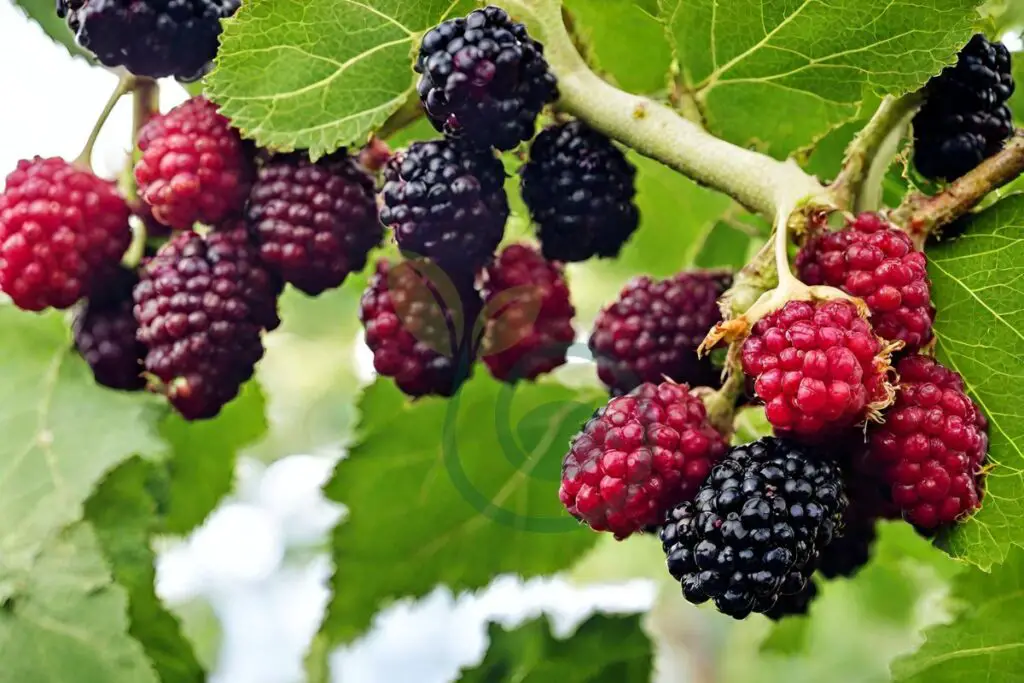
Health Impacts
While mulberries offer numerous health benefits, it's important to note that individual experiences may vary. Maintaining a balanced diet is always recommended regardless of the potential advantages of consuming these berries. It's wise to enjoy them as part of an overall nutritious eating plan for optimal well-being.
Culinary Uses
Using Mulberries
Mulberries are versatile in the kitchen, suitable for making jams, jellies, and sauces. They can also enhance salads with their vibrant color and unique flavor profile. Mulberry leaves have culinary value; they can be brewed into tea or incorporated into traditional herbal remedies.
Consider trying them in various recipes. For instance, blend fresh mulberries with yogurt and honey to create a refreshing smoothie. Another delightful option is crafting a mouthwatering mulberry pie using a flaky pastry crust filled with sweetened mulberries. Moreover, you can experiment with making homemade mulberry jam by cooking down the berries with sugar and lemon juice until achieving a thick consistency.
Recipe Ideas
- Mulberry Smoothie: Blend fresh mulberries with yogurt and honey.
- Mulberry Pie: Create a delicious pie using sweetened mulberry filling.
- Mulberry Jam: Make homemade jam by simmering berries with sugar and lemon juice.
Incorporating these recipe ideas not only adds variety to your meals but also allows you to enjoy the unique taste of fresh mulberries while benefiting from their nutritional content.
Closing Thoughts
So, can you eat those tempting berries hanging from the mulberry tree in your backyard? Absolutely! Armed with the knowledge of identifying, locating, and safely foraging for mulberries, as well as understanding their flavor profile, health benefits, and culinary uses, you're all set to enjoy nature's delicious bounty. Remember to propagate responsibly and manage the tree's invasiveness to maintain a healthy balance.
Now that you're equipped with the essentials about mulberries, go out there and explore the world of foraging with confidence. Embrace the joy of discovering these flavorful gems and incorporating them into your meals. Whether you're a seasoned forager or just starting, mulberries offer a delightful experience waiting to be savored. Happy foraging!
Frequently Asked Questions
Can you eat mulberries straight from the tree?
Yes, you can eat mulberries straight from the tree. Make sure they are ripe and fully colored for the best taste experience.
Are all mulberries safe to eat?
Not all varieties of mulberries are safe to consume. It's essential to correctly identify the species before consuming any berries off a mulberry tree.
How do I know if a mulberry is ripe enough to be eaten?
Ripe mulberries will be plump, juicy, and have a deep color – typically dark red or black depending on the variety.
What are some health benefits of eating mulberries?
Mulberries are rich in vitamins, minerals, and antioxidants which support immune function, aid digestion, and promote overall well-being when consumed as part of a balanced diet.
Can I use fresh mulberries in cooking or baking recipes?
Fresh mulberries can be used in various culinary applications such as jams, pies, smoothies, salads or simply enjoyed on their own. They add a sweet-tart flavor profile to dishes.
Image Source: Paid image from CANVA

